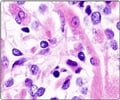Scientists at the Stanford University School of Medicine have found a way to watch tumor cells committing a form of programmed suicide called apoptosis.
Scientists at the Stanford University School of Medicine have found a way to watch tumor cells committing a form of programmed suicide called apoptosis. This finding may improve the desired effects of workhorse cancer treatments such as chemotherapy and radiotherapy.
Apoptosis is a carefully orchestrated sequence of intracellular events that leads to the cell's death. "The cell takes itself apart in a finite series of steps," said Matthew Bogyo, PhD, associate professor of pathology and of microbiology and immunology, and a member of the Stanford Cancer Center.Bogyo is senior author of a study to be published online July 13 in Nature Medicine in which he and his Stanford colleagues demonstrated in mice that it is possible to noninvasively image the degree of apoptosis occurring in living animals' tumors, and thereby to gauge the effectiveness of apoptosis-inducing treatments. Several steps still remain before it can be determined whether this diagnostic method is safe for use in humans.
Apoptosis occurs all the time in healthy bodies. Cells have this suicide system in place to deal with viral infections, or just to complete their normal life cycle. Cells lining the gut, for example, or immune cells in the spleen and thymus are meant to live only a couple of days. "You lose three-quarters of a million cells per second in your body due to apoptosis," noted Guy Salvesen, PhD, director of the program on apoptosis and cell-death management at the Burnham Institute for Medical Research, in La Jolla, Calif.
But apoptosis is also a check against unwanted cell division, as occurs during tumor growth, said Salvesen, who collaborates with Bogyo on various research projects but did not participate in this study. "Cancer cells have to learn to do two things," Salvesen said. "First, they've got to learn to start dividing rapidly. But once they do that, they become very vulnerable to apoptosis. So they've got to learn to switch off this death mechanism. Chemotherapy and radiotherapy aim to turn it back on."
One way of determining whether they're succeeded is by monitoring key early players in apoptosis called caspases, a family of usually quiescent enzymes found inside every mammalian cell. Activated by various biochemical cues from within or outside of the cell, caspases commence a cascade of molecular steps that steer the cell to a clean, quiet, orderly death.
"Caspases have to be very tightly controlled, since they are regulating cell death. If they get turned on, the cell dies," said Bogyo. His team created probes by affixing fluorescent "tags" to small molecules that were engineered to bind — and stay bound — almost exclusively to caspases, and only when the caspases are in an active state. The resulting probes are excited by certain wavelengths of light that travel through skin without being absorbed. The probes respond by giving off their own light, which can be imaged by a special detector.
Advertisement
In an early test of the probe, Bogyo and his colleagues gave mice a drug called dexamethosone, which preferentially induces apoptosis in certain immature immune cells residing primarily in the thymus. After systemically injecting a solution containing the probes, the investigators observed fluorescence in the thymus, as predicted. They confirmed by chemical methods that the fluorescent probes were indeed binding to caspases.
Advertisement
The potential for practical payoffs is significant, Bogyo said. Radiotherapy and many chemotherapeutic selectively damage DNA in rapidly replicating cells, dramatically boosting the amount of apoptotic death happening in tumors. Some experimental models indicate that inducing apoptosis is the main way these treatments kill cancer cells.
"Different individuals respond differently to a given treatment. The quicker you can make a decision about whether a drug is working or not, the better," Bogyo said. Moreover, he said, new-generation drugs, some of them now in clinical trials, are designed specifically to turn on caspases.
Because caspase activation is a very early event in apoptosis, monitoring it could speed clinicians' ability to determine whether, how and when these new drugs work, said Bogyo. He has started a company, Akrotome, to speed the fluorescent probes' development and commercialization. Stanford has licensed this technology to Akrotome for a 4 percent ownership stake.
"The entire cancer chemotherapy field is very, very excited about probes like this," said the Burnham Institute's Salvesen, who has no financial ties to the current study or to Akrotome. The approach also holds promise for tracking unwanted apoptotic damage to tissues in disorders such as macular degeneration or traumas such as post-ischemic reperfusion injury.
Source-Eurekalert
RAS














